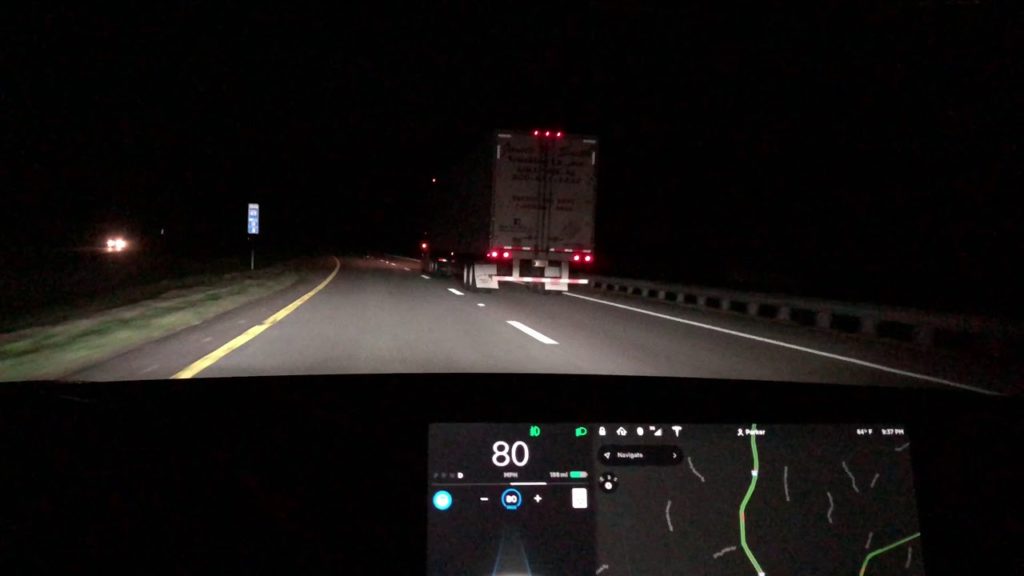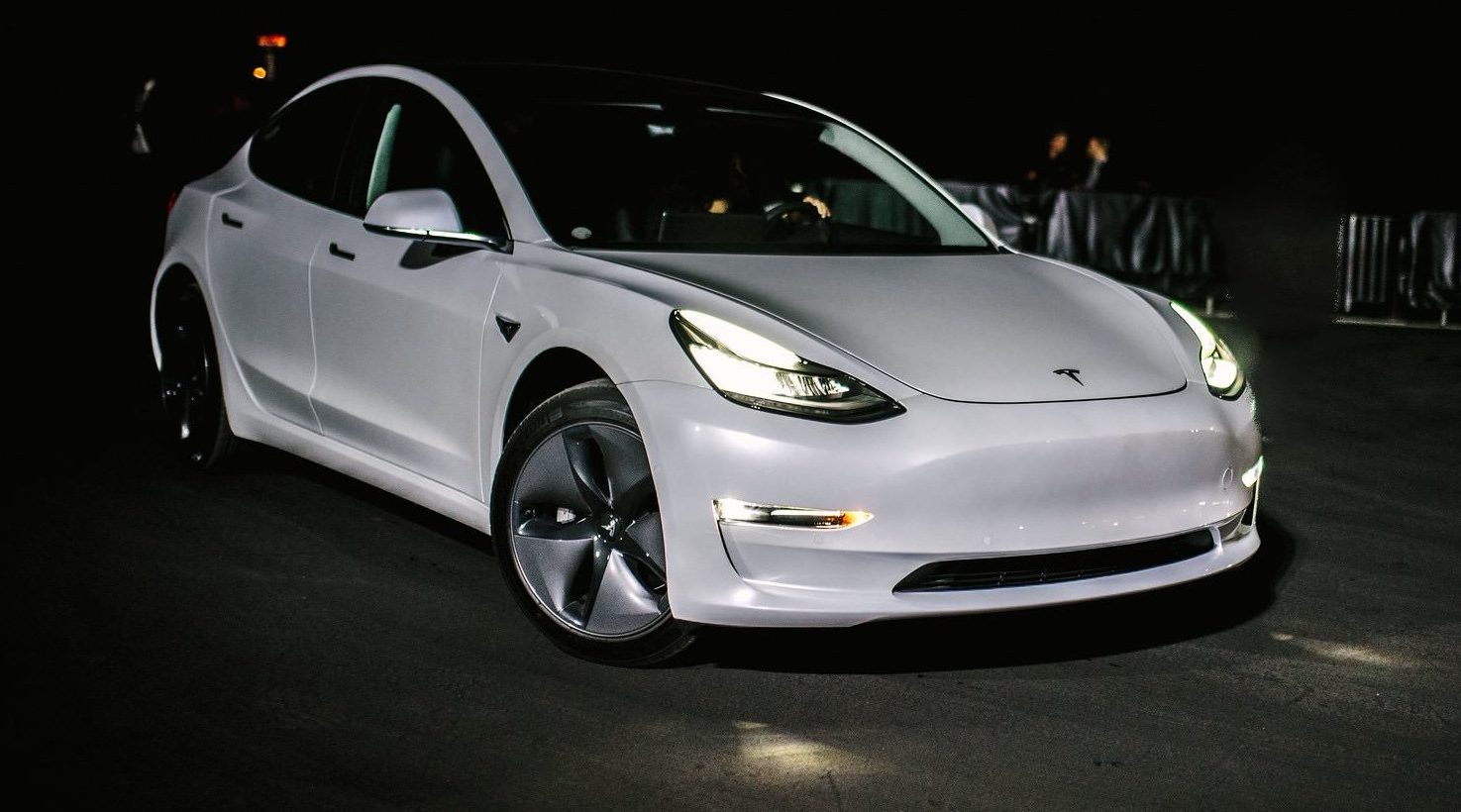
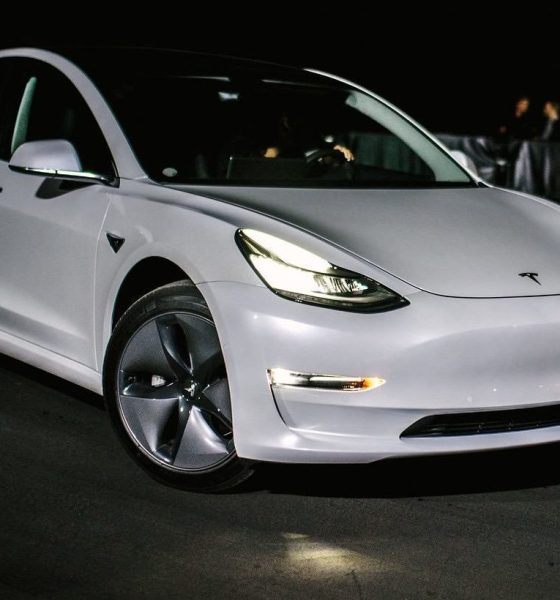
News
No, Tesla wasn’t “cheated” in the Model 3 headlight safety test by the IIHS
With the Insurance Institute for Highway Safety’s release of initial crash test information for the Tesla Model 3 came cries from many in the electric vehicle community that Tesla was “being cheated.” This isn’t entirely true as the new IIHS test removes a lot of cars out of the Top Safety Pick+ rating, the highest accolade the independent safety tester will give a car.
The Insurance Institute for Highway Safety (IIHS) is an independent testing organization funded by insurance companies and some of the banks who back them. The IIHS purchases every car it tests–usually several of each–and tests these vehicles in their highest-available safety configuration. These crash tests usually destroy the vehicles in question, of course, but give an independent, third-party result not otherwise available.
When the IIHS’ initial safety results for the Tesla Model 3 were released, they included ratings for only two of the seven total ratings given to a vehicle. Those ratings, posted to the IIHS.org website, created a lot of response from the community regarding the failure of the Model 3’s headlamps to pass muster.
The tests so far include only the non-invasive, non-destructive tests normally conducted by the IIHS. Namely to crash mitigation systems and headlamps. It’s likely that the next test to see release on the Model 3 will be for LATCH child safety system use, another non-destructive test. From there, crash testing will begin. For that, IIHS needs to receive more Model 3 vehicles (5 in all), the rest of which are on order and expected later this year. Like any other Model 3 buyer, delays in manufacturing have put the IIHS’ ownership of the cars for evaluation on hold.
How the IIHS Conducts Headlight Tests, and Why
The IIHS conducts headlamps tests because, according to the organization, about half of all fatal crashes in the U.S. occur in the dark and many of those are on unlit roads where headlamps are the only thing illuminating whatever’s in front of the car. Although headlights are mandatory and minimum illumination requirements are required by law for all street-legal vehicles, there is a wide variance in how much (and how useful) that illumination can be. Especially with the advent of new lighting technologies.
“Headlight technology has been developing rapidly in recent years. LED and high-intensity discharge (HID) lamps have begun to replace the traditional halogen ones,” IIHS explains on its website. “Many automakers offer curve-adaptive headlights, which respond to steering and swivel according to the direction of travel. Many also offer high-beam assist, a feature that can increase the use of high beams..” These and other variables mean that headlights of the same type on one vehicle can be much worse than they can on another. Even little things like how the lights are focused, what type of light they emit, etc. can change effectiveness.
For those reasons, the IIHS instituted a headlight testing methodology in 2016. Starting this year (2018), these test results directly affect a vehicle’s eligibility for Top Safety Pick+ status. So far in 2018, only a handful of models have received TSP+ ratings. Somewhat surprising for luxury and high-end car buyers is the fact that almost all of those TSP+ vehicles are lower-end vehicles from makes like Hyundai and Subaru.
Testing for headlamps is conducted using a multi-part evaluation using a hypothetical, clear, two-lane road. The tests include measurements in a straightaway, measuring both the length and amount of illumination as well as the amount of glare the lights create for oncoming drivers. Then a gradual left- and right-hand turn and a steeper left- and right-hand curve are measured for a total of five directions in all.
Results are taken from varied distances at 10 inches high and 3-feet, 7-inches high (from the ground) to mimic where the driver is looking (out and down) and where oncoming vehicle drivers are seeing from (higher up). Ratings are then assigned according to how these measurements line up with a hypothetical ideal headlight system. Both low and high beams are tested the same way with the low beams being weighted for scoring as they are used most often in the real world. Vehicles with automatic high beam systems are given more points as the high beams will be used more often.
The Controversy Surrounding the IIHS Headlight Test
The inherent weakness in this IIHS test is similar to that of most of its advanced testing: it’s only tested on the ideal vehicle trim level and options. In other words, the testing is most likely happening on the most expensive model being sold, not necessarily on the most mainstream version of the vehicle. This becomes obvious when the bulk of the Top Safety Pick+ list is comprised of vehicles like the 2018 Subaru WRX.
The WRX is a great car, sure; a personal favorite in fact. But its winning of a TSP+ badge is a little misleading. The volume-selling model WRX is the mid-tier Premium trim, which doesn’t include the LED headlights or the automatic high beam control tested by the IIHS. To get those, one has to go up to the more expensive Limited trim point and add the EyeSight system. That latter point can only come if the buyer of this driver’s car is willing to drop their manual transmission for a CVT. That’s another sticking point as the WRX has a large percentage of buyers who want to shift the gears themselves.
What all of this means is that the 2018 WRX is a great car, but it’s not likely to be purchased in the configuration which the IIHS used to test its headlamps with. Other cars on the TSP+ list are much the same.
The interesting note here is that unlike actual crash tests, the slightly more subjective headlamp tests of the IIHS fall into the non-destructive tests for other safety equipment that, while respected, are also flawed for the same reason: only top-end models tend to have all of that equipment on them. Unlike those other safety items, however, the headlamp tests can hurt higher-end models while lower-end options would ace them. Why? Because LED headlamps, which consistently appear to fail most of the glare testing that the IIHS does, are generally only found on top-end models or luxury vehicles. There could be a lot of reasons for that, but my personal theory is that it has to do with automakers having to find a median between maximum safe illumination and glare due to how reflective LED lamps are designed.
The current IIHS Top Safety Pick+ list includes no midsize luxury cars (which the Model 3 is considered), though the overall midsize car category has five entries. All of them with caveats as to what must be included (usually top trim point items or options). Last year, under the old rules, most midsize and midsize luxury cars made the TSP+ list and Tesla’s Model S failed to make the list in part, again, for headlights.
It’s difficult to say what will happen with the Insurance Institute’s testing going forward. Likely manufacturers will come up with solutions to receive better scores on the headlamps test, perhaps by changing LED lighting designs or gaming the IIHS tests (as they have in the past with the small front overlap).
Tesla has some smart engineers and could probably figure out a way to remedy the lighting problem that’s kept their vehicles from rating high on IIHS tests in recent years. With a mainstream attempt like the Model 3, that could become a very important goal as buyers in the midsize sedan category tend to be safety conscious consumers.

News
Tesla 2025 Holiday Update: Here’s what it includes, and what it’s missing
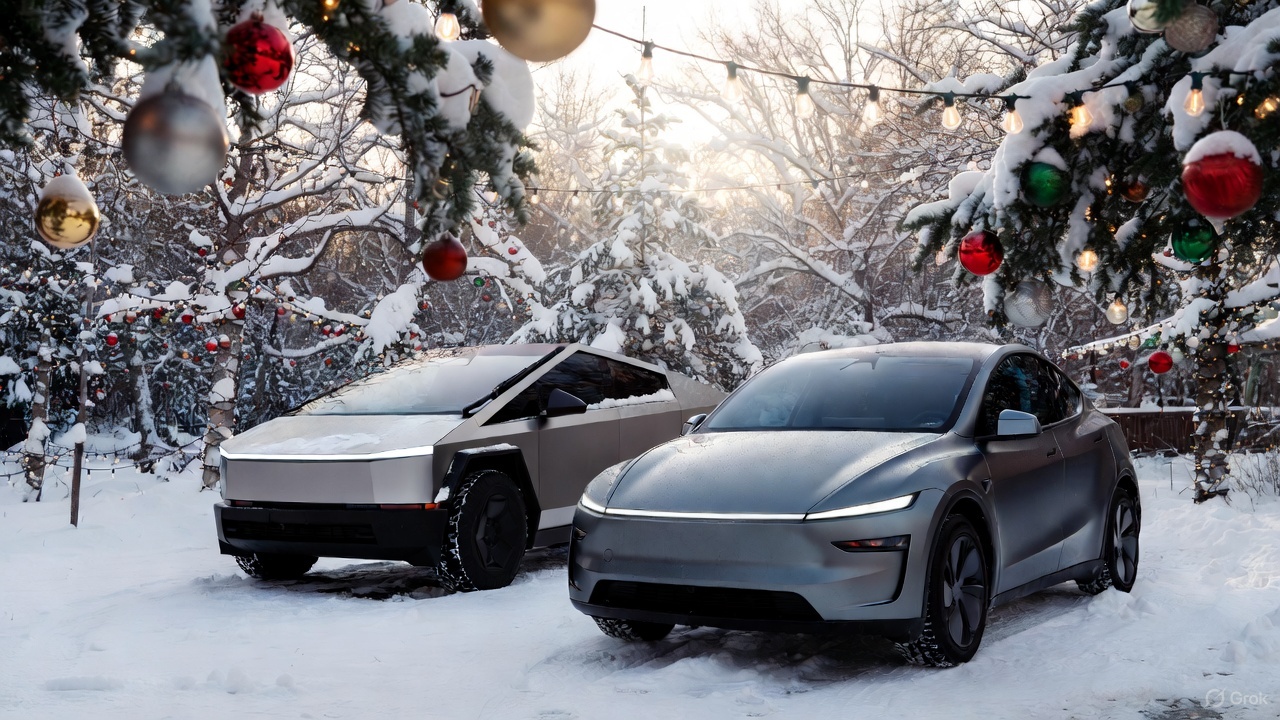
Tesla has finally announced the features for the 2025 Holiday Update, which includes a wide variety of new inclusions that are both functional and just for fun.
The new features are plentiful, but there were a handful of things we were expecting to see based on what we know. We don’t want to sound ungrateful, because there are a lot of great new things on the way with this update.
Here’s what was included:
Grok with Navigation Commands (Beta)
Grok will now have the ability to add and edit navigation destinations, which is a drastic improvement considering Tesla owners had to use their standard voice commands for this in the past.

The utilization of Grok will likely improve the navigation experience by offering some insight into your destination, including reviews and other points of interest nearby.
It will be enabled by using Grok’s “Assistant” personality.
Tesla Photobooth
“Turn your car into a photobooth! Take selfies from inside your Tesla & give yourself a makeover with fun filters, stickers, and emojis. Share with others right from the Tesla app.”
This feature will be available within the Toybox.
Dog Mode Live Activity
When using Dog Mode to keep your four-legged friend comfortable in the car, you’ll now be able to check in on them as it will share periodic snapshots of the cabin, along with live updates on temperature, battery, and climate conditions.
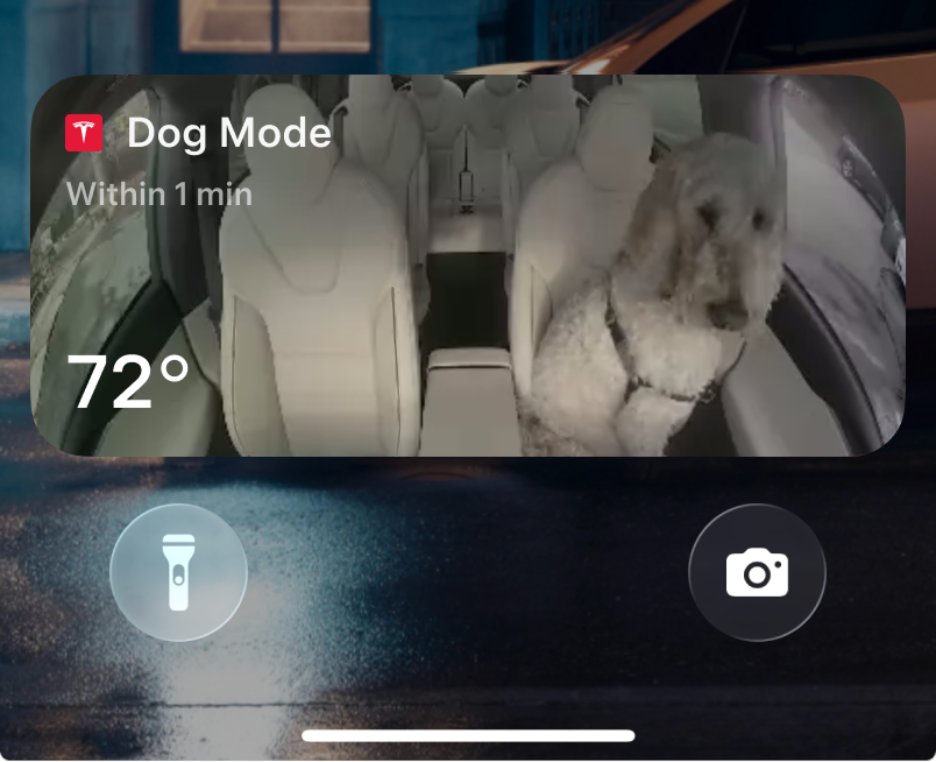
Dashcam Viewer Update
Dashcam clips are awesome, but they’re void of a lot of information, which could be useful in some instances, especially if there is an accident.
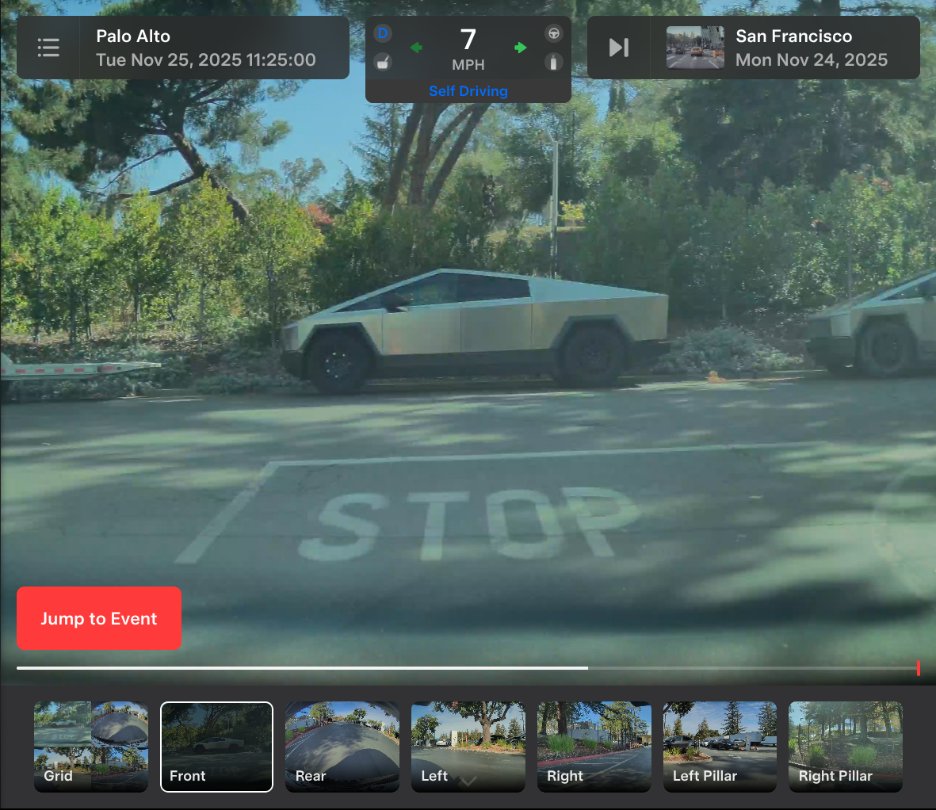
Now, there will be additional details included on each Dashcam clip, like speed, steering wheel angle, and Self-Driving state.
Santa Mode
New graphics, trees, and a lock chime are now available.

Light Show Update
A new Light Show, called Jingle Rush, will be available.
Custom Wraps and License Plates in Colorizer
Colorizer will now be known as “Paint Shop” in the Toybox. You will now be able to personalize your Tesla Avatar with window tints, custom wraps, and license plates. Preloaded designs will be available, but owners will be able to use their USB Flash Drives to create one that suits their style.
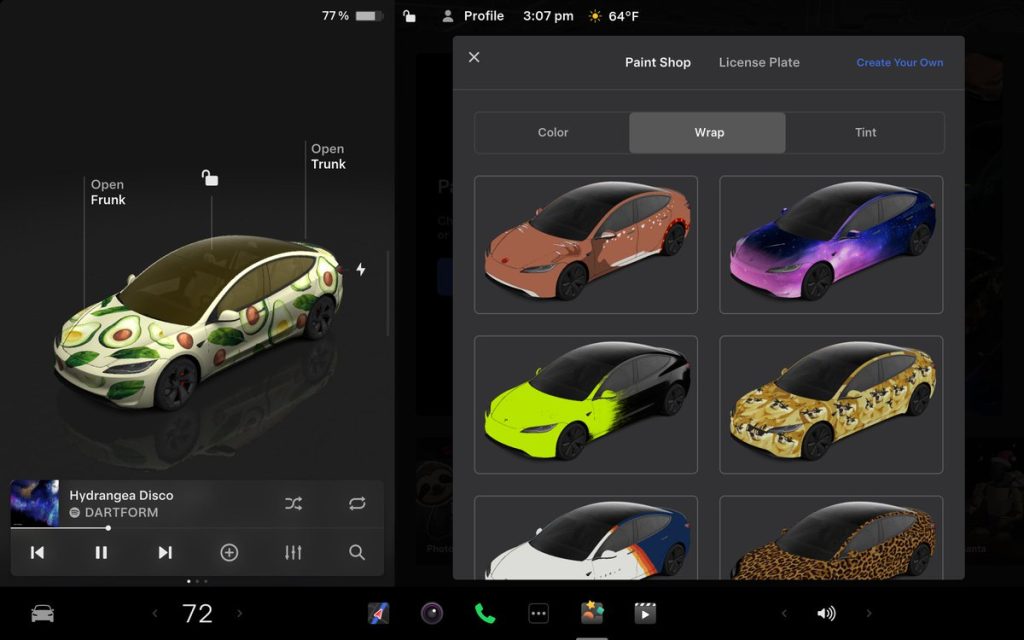
Navigation Improvements
Changing the order of your destinations will be easier through a new “Favorites” tab, and Home and Work can now be set by dropping a pin.
There will also be “Suggested Destinations,” which will be determined through recent trips and habits while parked.
Supercharger Site Map
Perhaps the most significant feature of the Holiday Update, Tesla is adding a 3D view of select Tesla Superchargers by tapping “View Site Map.”
When navigating to a location with this capability, the site layout, live occupancy, and nearby amenities will be available. Drivers will also be able to choose which stall to Supercharge.
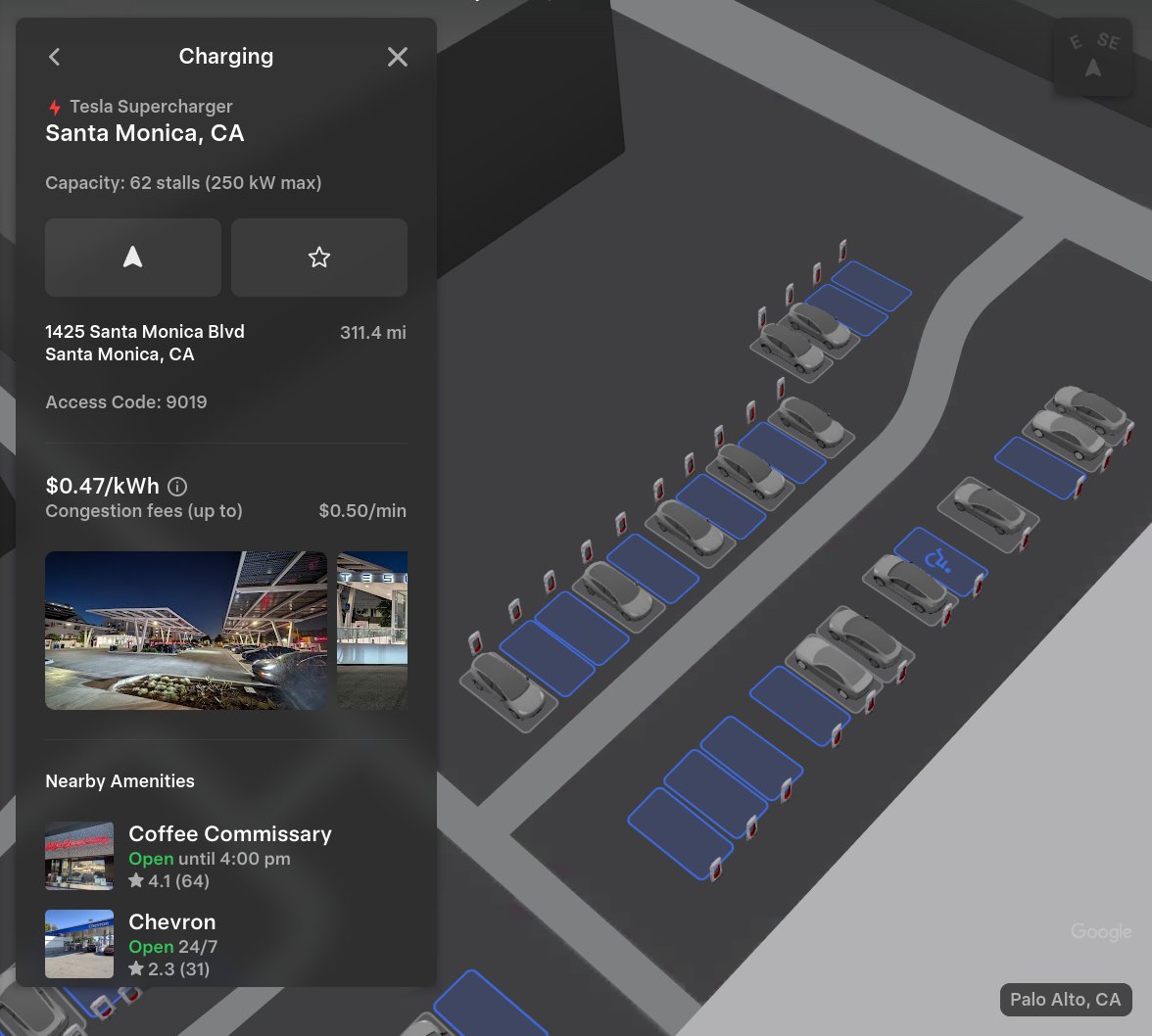
This is only available at a handful of locations currently, but it will expand to more Superchargers as it becomes more robust.
Automatic Carpool Lane Routing
Navigation will include an option to utilize carpool lanes. Your route will automatically choose the carpool lane when eligible.
Phone Left Behind Chime
If the in-car occupant detection system does not see anyone in the car and there is a phone key, or if a phone is left inside the cabin, your Tesla will chime a few seconds after the doors close.
Charge Limit Per Location
You can now save a charge limit for the current location while parked and it will be applied automatically the next time you charge there.
ISS Docking Simulator
In a SpaceX collaboration, Tesla has added this game to its in-car Arcade:
“Become an astronaut and prove your skills by docking with the International Space Station. Control & guide the rocket in this 3D docking simulator game using a set of controls based on actual interfaces used by NASA astronauts.”
Additional Improvements
-
Enable or disable wireless phone charging pads in Controls > Charging (S3XY) or Controls > Outlets & Mods (Cybertruck)
-
Add Spotify tracks to your queue right from the search screen & scroll through large Spotify playlists, albums, podcasts, audiobooks & your library seamlessly, without paging
-
Take the vibes up another level with rainbow colors during Rave Cave. Accent lights color will change along with the beats of your music. App Launcher > Toybox > Light Sync
-
Lock Sound now includes Light Cycle from Tron Mode. Toybox > Boombox > Lock Sound
What’s Missing
There are a handful of features we expected to see with the Holiday Update, but were not included.
Banish Feature
Tesla has been teasing the Banish functionality for quite a few years, but evidently, it is not quite there yet.
Banish will allow owners to get out of their vehicle at the entrance of their destination, and the car will go find a spot and park itself. Some refer to it as “Reverse Summon.”
Apple CarPlay
With all of the rumors regarding Apple CarPlay and then the evidence that Tesla was working to bring CarPlay to vehicles, we really expected it to come with the Holiday Update.
We’re not upset it’s not here, though. Tesla’s in-car UI is significantly better, at least in our opinion.
Parking Spot Selection
One of the biggest gripes about the new Arrival Features with Full Self-Driving v14 is that choosing a set parking spot is not available. This is especially frustrating for Tesla owners who rent or live in townhouse neighborhoods or apartment complexes with assigned parking.
Tesla seems to be working on this based on the release notes for v14.2, where it said future capabilities would include Parking Spot Selection.
News
Man credits Grok AI with saving his life after ER missed near-ruptured appendix
The AI flagged some of the man’s symptoms and urged him to return to the ER immediately and demand a CT scan.

A 49-year-old man has stated that xAI’s Grok ended up saving his life when the large language model identified a near-ruptured appendix that his first ER visit dismissed as acid reflux.
After being sent home from the ER, the man asked Grok to analyze his symptoms. The AI flagged some of the man’s symptoms and urged him to return immediately and demand a CT scan. The scan confirmed that something far worse than acid reflux was indeed going on.
Grok spotted what a doctor missed
In a post on Reddit, u/Tykjen noted that for 24 hours straight, he had a constant “razor-blade-level” abdominal pain that forced him into a fetal position. He had no fever or visible signs. He went to the ER, where a doctor pressed his soft belly, prescribed acid blockers, and sent him home.
The acid blockers didn’t work, and the man’s pain remained intense. He then decided to open a year-long chat he had with Grok and listed every detail that he was experiencing. The AI responded quickly. “Grok immediately flagged perforated ulcer or atypical appendicitis, told me the exact red-flag pattern I was describing, and basically said “go back right now and ask for a CT,” the man wrote in his post.
He copied Grok’s reasoning, returned to the ER, and insisted on the scan. The CT scan ultimately showed an inflamed appendix on the verge of rupture. Six hours later, the appendix was out. The man said the pain has completely vanished, and he woke up laughing under anesthesia. He was discharged the next day.
How a late-night conversation with Grok got me to demand the CT scan that saved my life from a ruptured appendix (December 2025)
byu/Tykjen ingrok
AI doctors could very well be welcomed
In the replies to his Reddit post, u/Tykjen further explained that he specifically avoided telling doctors that Grok, an AI, suggested he get a CT scan. “I did not tell them on the second visit that Grok recommended the CT scan. I had to lie. I told them my sister who’s a nurse told me to ask for the scan,” the man wrote.
One commenter noted that the use of AI in medicine will likely be welcomed, stating that “If AI could take doctors’ jobs one day, I will be happy. Doctors just don’t care anymore. It’s all a paycheck.” The Redditor replied with, “Sadly yes. That is what it felt like after the first visit. And the following night could have been my last.”
Elon Musk has been very optimistic about the potential of robots like Tesla Optimus in the medical field. Provided that they are able to achieve human-level articulation in their hands, and Tesla is able to bring down their cost through mass manufacturing, the era of AI-powered medical care could very well be closer than expected.
News
Tesla expands Model 3 lineup in Europe with most affordable variant yet
The Model 3 Standard still delivers more than 300 miles of range, potentially making it an attractive option for budget-conscious buyers.

Tesla has introduced a lower-priced Model 3 variant in Europe, expanding the lineup just two months after the vehicle’s U.S. debut. The Model 3 Standard still delivers more than 300 miles (480 km) of range, potentially making it an attractive option for budget-conscious buyers.
Tesla’s pricing strategy
The Model 3 Standard arrives as Tesla contends with declining registrations in several countries across Europe, where sales have not fully offset shifting consumer preferences. Many buyers have turned to options such as Volkswagen’s ID.3 and BYD’s Atto 3, both of which have benefited from aggressive pricing.
By removing select premium finishes and features, Tesla positioned the new Model 3 Standard as an “ultra-low cost of ownership” option of its all-electric sedan. Pricing comes in at €37,970 in Germany, NOK 330,056 in Norway, and SEK 449,990 in Sweden, depending on market. This places the Model 3 Standard well below the “premium” Model 3 trim, which starts at €45,970 in Germany.
Deliveries for the Standard model are expected to begin in the first quarter of 2026, giving Tesla an entry-level foothold in a segment that’s increasingly defined by sub-€40,000 offerings.
Tesla’s affordable vehicle push
The low-cost Model 3 follows October’s launch of a similarly positioned Model Y variant, signaling a broader shift in Tesla’s product strategy. While CEO Elon Musk has moved the company toward AI-driven initiatives such as robotaxis and humanoid robots, lower-priced vehicles remain necessary to support the company’s revenue in the near term.
Reports have indicated that Tesla previously abandoned plans for an all-new $25,000 EV, with the company opting to create cheaper versions of existing platforms instead. Analysts have flagged possible cannibalization of higher-margin models, but the move aims to counter an influx of aggressively priced entrants from China and Europe, many of which sell below $30,000. With the new Model 3 Standard, Tesla is reinforcing its volume strategy in Europe’s increasingly competitive EV landscape.
